
Jay Vollmar

Audio By Carbonatix
The first Rush to the Rockies revved up in 1859, the year after a group of prospectors from Georgia found gold in the South Platte River, just up from its confluence with Cherry Creek. These ’59ers weren’t rushing to an uninhabited land, of course; the real natives had lived in the area for centuries, and members of the Arapaho tribe regularly camped amid the cherry trees by the junction of the two waterways. But the Arapaho, as well as other tribes that had been pushed into the area by rapid settlement further east, would soon be driven from first Denver and then Colorado altogether, in a far more dramatic example of gentrification than what’s currently occurring in this state, and in a much more violent clash between natives and newcomers than what we see today.
Conflict often explodes in a boom town. And those who forget the past might very well relive it.
With so many people flooding Denver these days, history is often obscured by hysteria, historic facts covered by fake news. But for all the transplants – as well as longtime Denverites who’ve forgotten their civics lessons or skipped them altogether – History Colorado is now providing a primer with Zoom In: The Centennial State in 100 Objects, an exhibit that draws from its collection to offer a true object lesson in Colorado history.
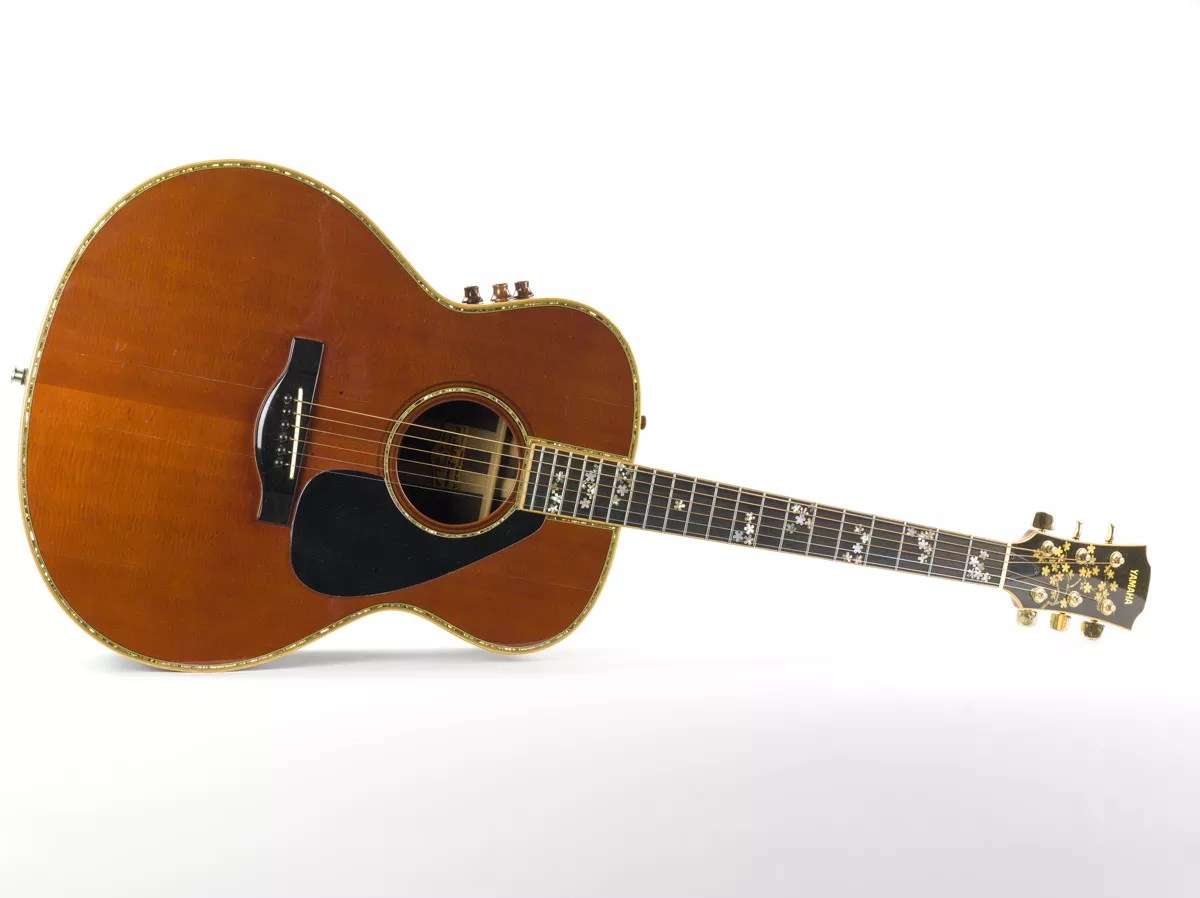
John Denver
Courtesy History Colorado Center
The mass migration to the Rockies didn’t end with that initial gold rush: It continued through the 1890s and included not just prospectors, but entrepreneurs who saw possibilities in mining the miners, as well as people looking for increasingly rare empty spaces where they could create their own opportunities. More migrations followed: after World War II, as servicemen who’d been based here returned to create new lives, some of them in the emerging winter recreational industry; in the ’70s, as droves of young people headed west in search of a more open atmosphere and a more accommodating lifestyle, a movement set to the soundtrack of John Denver, who’d recorded “I Guess He’d Rather Be in Colorado” in 1971.
And then another migration began ten years ago, as the country sank into a recession and Denver, with its sunny disposition and stunning setting, became the top destination for millennials…even before Coloradans legalized recreational marijuana in November 2012. That decade-old trend hasn’t ended yet (though it has been slowing); Denver is still gaining tens of thousands of new residents a year, and rent prices and tensions have risen along with the population.
“Through the 1890s, people were coming to Colorado for a variety of reasons, hoping to find opportunity and make a better life,” says Jason Hanson, the deputy state historian who helped coordinate Zoom In, noting that those reasons still motivate transplants today. “There are not a lot of times when Colorado has been an unattractive destination. This is a trend that has been on people’s radar for decades.”

Shield cover (Southern Cheyenne, attributed to Lame Bull, about 1850).
Courtesy History Colorado Center
Just twenty years after the first Rush to the Rockies, and only three years after the booming region became the State of Colorado (an action delayed by at least a decade because of the way newcomers treated the real natives), the State Historical Society of Colorado was founded in 1879. It later morphed into the Colorado Historical Society and then into History Colorado, which moved into the brand-new History Colorado Center at 1200 Broadway in April 2012; History Colorado also runs twelve historic sites and museums at ten locations around the state. It is both a nonprofit and part of the Colorado Department of Higher Education – and over the past five years, it’s provided a major education in how a cultural institution dedicated to the past has to prepare for the future.
Intent on drawing new audiences to its big new building – an impressive structure designed by David Tryba and Tryba Architects – History Colorado initially brought in blockbuster exhibits that had little to do with Colorado (Toys, 1968) and everything to do with crowd appeal. While the crowds did come, they found little to return for beyond the center itself, with its marvelous inlaid map of Colorado in the lobby that visitors could ride over on time machines, taking trips back into the past as a particular location activated a story. (Technology isn’t everything: Those time machines are currently out for repair.) Meanwhile, regulars of the old history museum wondered what had happened to all the items once displayed there, including the dioramas and timelines.
Some pieces in the collection had been used for a handful of “Colorado Stories,” exhibits that opened along with the History Colorado Center, but those proved problematic. A few were simply dumbed-down and Disneyfied: a trip through a Colorado mine, a chance to try a ski jump. Others had historical inaccuracies. For example, the area dedicated to Amache, the World War II Japanese internment camp located outside Granada, looked more like a ritzy summer camp than the barracks that housed thousands of American citizens. Although the display remains, after years of objections an advisory was added noting that because of ADA-compliance issues, the reconstruction was not to scale; it made the accommodations look far grander than was the case. The story devoted to Bent’s Fort was revised, too, to eliminate objectionable cartoon caricatures of Native Americans and also a completely fictitious soldier.
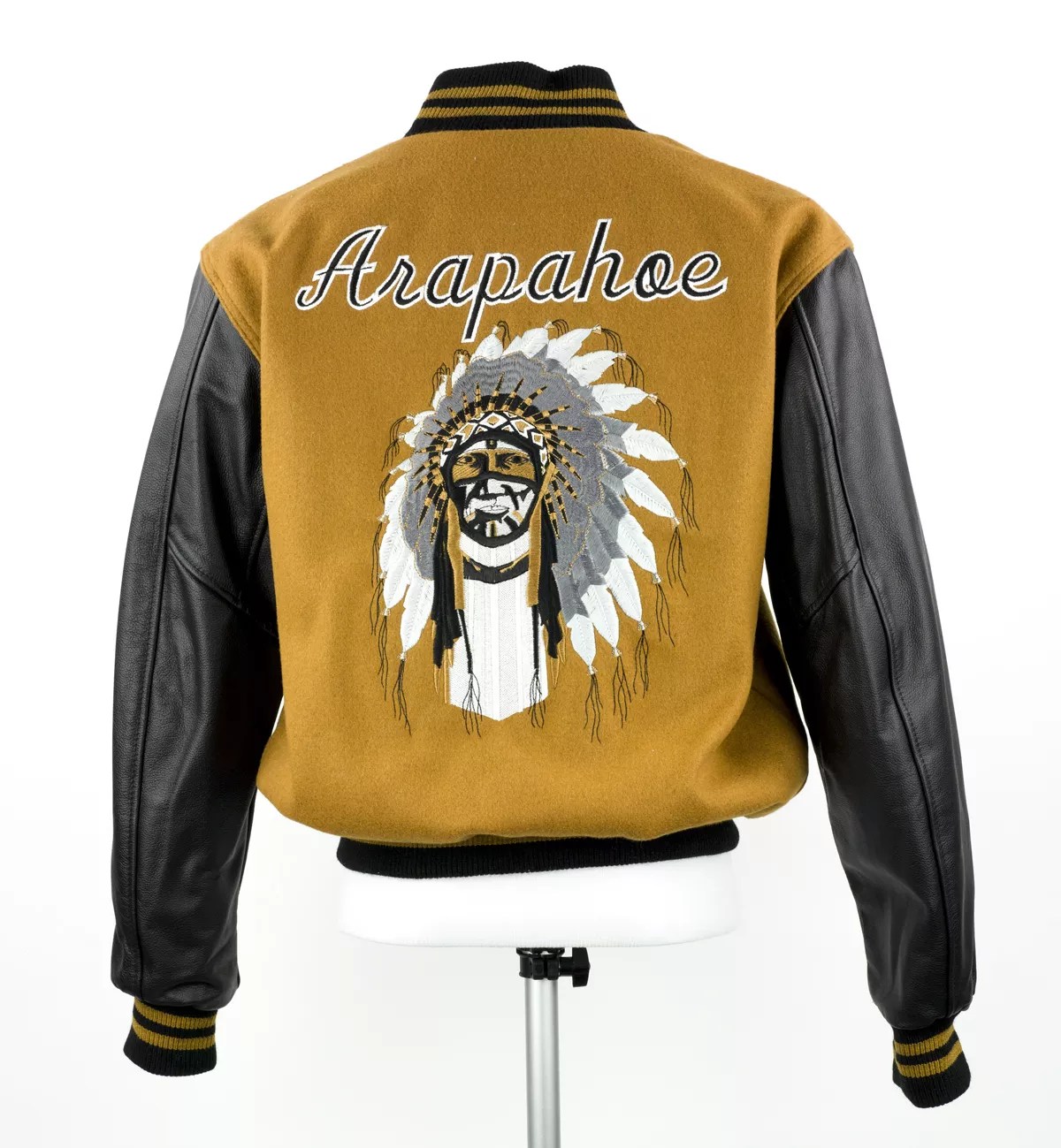
The logo of a 2006 Arapahoe High School letter jacket echoes the image on a Cheyenne shield.
Courtesy History Colorado Center
By far the most controversial of the “Colorado Stories,” though, was Collision, which was supposed to tell the story of the Sand Creek Massacre, a dark chapter of Colorado’s history: On November 29, 1864, Colonel John Chivington had led hundreds of Colorado volunteers in a dawn raid on a peaceful camp of Cheyenne and Arapaho on the banks of Sand Creek, who believed they were under the protection of the Army. An estimated 200 people, most of them children, women and elderly men, were killed, their bodies desecrated and souvenirs from the slaughter paraded back in Denver. Descendants of the massacre complained that History Colorado had not held required consultations on the proposed exhibit with tribal members – requirements set by Congress when it approved the Sand Creek Massacre National Historic Site in southeastern Colorado in 2000 – and then proceeded to open a factually inaccurate exhibit over their objections. Collision was finally closed more than a year after the History Colorado Center opened; today History Colorado is continuing to meet with tribal representatives in hopes of one day opening a new exhibit that will not just depict the Sand Creek Massacre accurately, but will expand the scope to tell the much larger story of the Cheyenne and Arapaho, who fled the state after Sand Creek and today are located in Wyoming, Montana and Oklahoma.
The controversy over Collision and other problems – including budget and attendance issues – led to a major shakeup at the museum. In August 2015, several top officials of History Colorado were removed or decided to retire, and the ranks have continued to thin since then as the institution carefully tries to pick a path that ensures that it, too, does not become history.
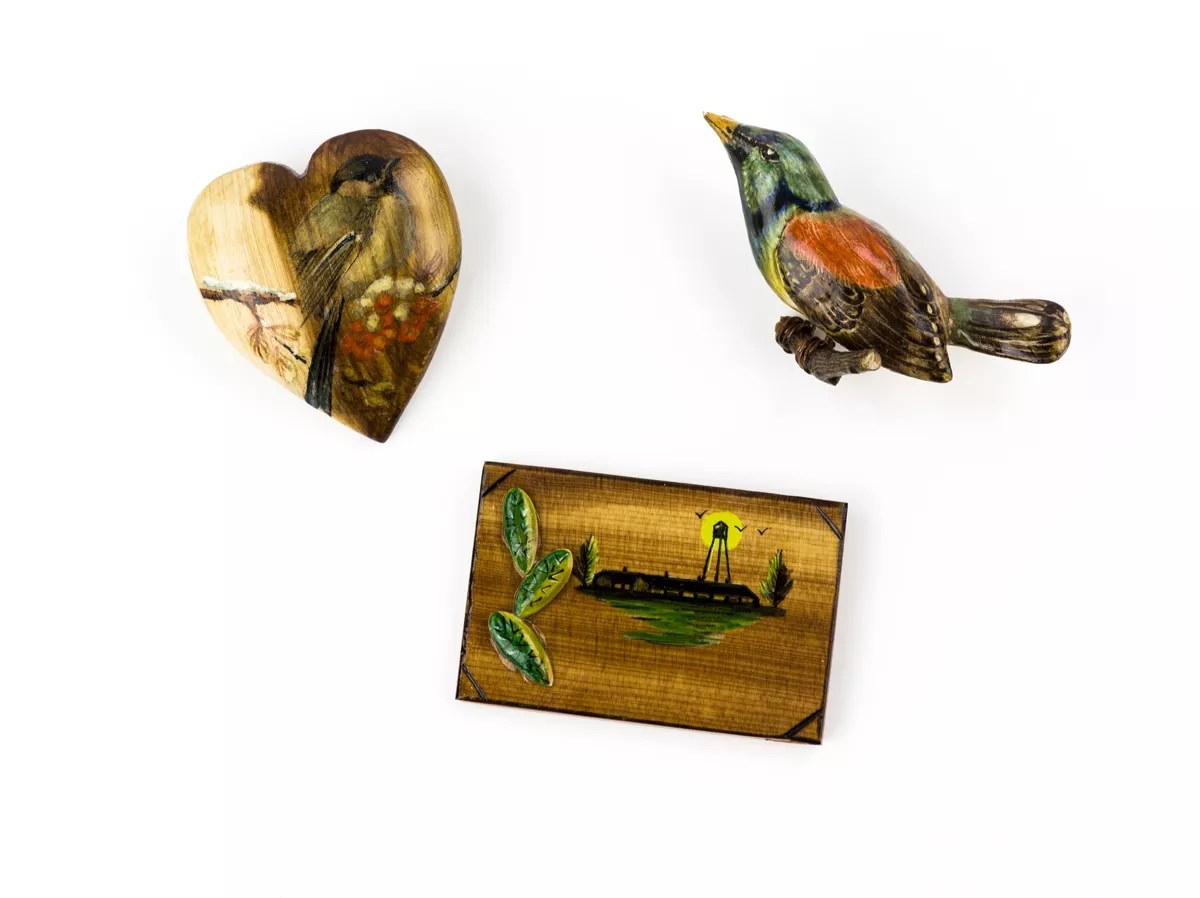
While imprisoned at Amache, Japanese Americans made these gaman pieces.
Courtesy History Colorado Center
In early 2016, University of Colorado professor Patty Limerick, who heads the CU-based Center for the American West, was named state historian in a collaboration between the two centers. Hanson, who’d gone to graduate school at CU and worked at the Center for the American West, was named deputy state historian. In June 2016, Steve Turner, the architect who’d left Historic Denver to become the state’s historic preservation officer in 2008 and had been named interim co-director of History Colorado after the shakeup, was elevated to the permanent executive director slot and charged with starting a new chapter for History Colorado.
Zoom In, the first major exhibit under the new regime, is a big step down that path, following in the more tentative footsteps of Backstory: Western American Art in Context, a collaboration between History Colorado and the Denver Art Museum that runs through February 11; it gives a much better idea of where History Colorado is headed. For starters, it occupies a new gallery added to the third floor, carved out of a boardroom and offices no longer needed for the smaller staff. A grant from the Boettcher Foundation, in honor of longtime leader Tim Schultz, covered the construction. The exhibit itself is presented by Colorado State University, which made a six-year commitment to the space.
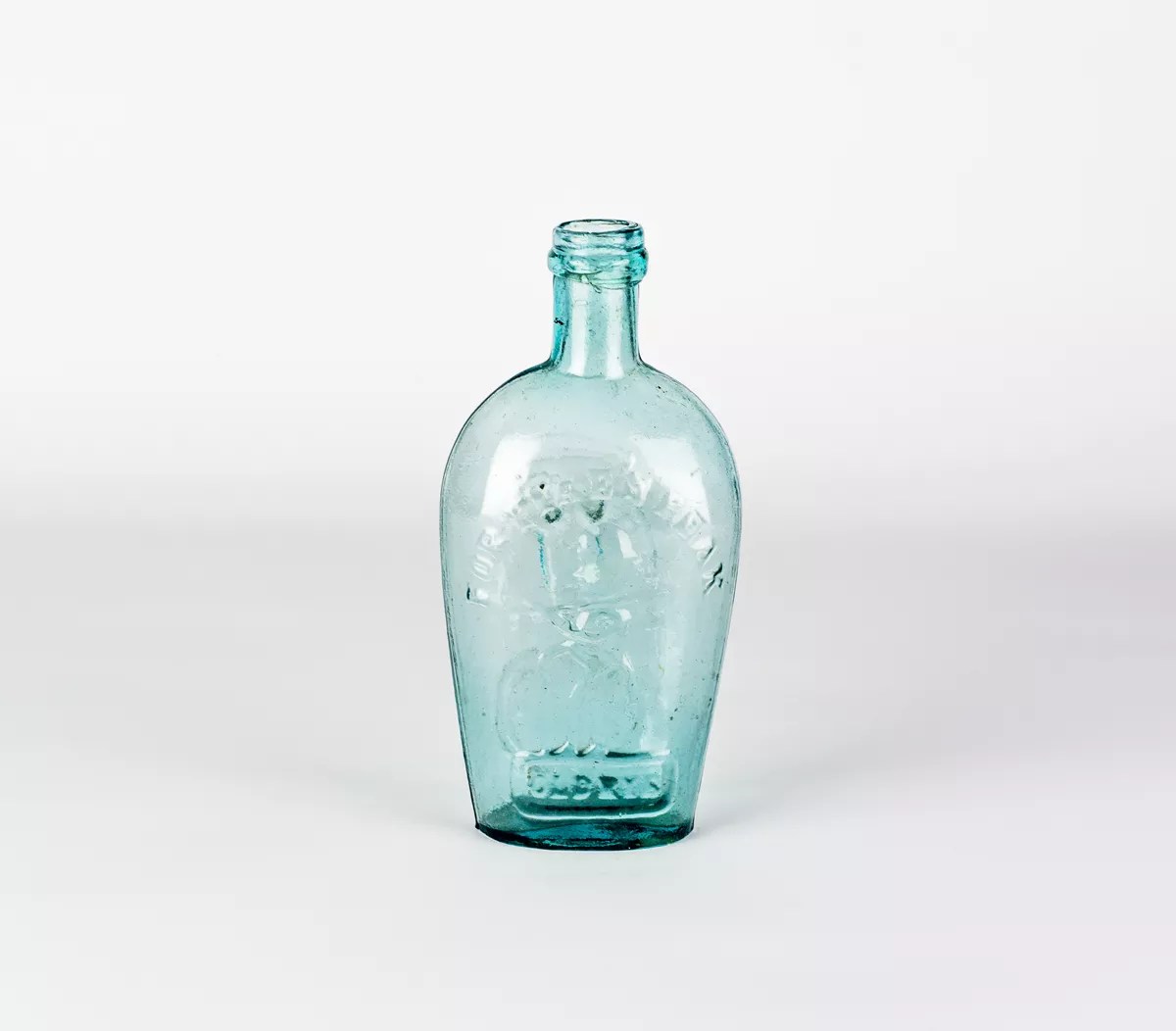
Fifty-niner
Courtesy History Colorado Center
But the more critical commitment is to exhibiting items from History Colorado’s own collection, which numbers about 15 million pieces. “As we were looking at our exhibit schedule and thinking about where we wanted to start, we thought this was an exhibit that History Colorado needs,” Hanson says of Zoom In, “with both pieces from the collection and the overview of Colorado history in one place.”
The original idea came from William Wei, a history professor at CU who’d been impressed by an exhibit at the British Museum that told the history of Great Britain through a hundred objects. The Smithsonian had also done a book on American history in a hundred objects. Wei brought the idea to History Colorado, and Turner and Hanson decided it would be a fine start. From there, James Peterson, a curatorial assistant with a vast knowledge of History Colorado’s collection, came up with a list of more than 200 significant objects. That list was shared with an advisory committee of twenty, including Limerick and former state historian David Halaas, who were asked to not only choose five must-include pieces from that roster, but also to think about any other objects that should be added, any chapters of Colorado history that were missing. At the same time, tribal representatives were consulted about possible inclusions, to avoid another Collision.
The advisory group helped whittle down the list of potential objects. There were too many guns, the advisors said; three wound up in the final roster. On their advice, History Colorado also decided to borrow a few items from outside the collection, including a civil-union license and a wedding dress worn by the daughter of a Chinese immigrant. “Every time we could bring the ghosts of the past to life, we took that opportunity,” explains Hanson. The bridal gown was a very different way to tell the story of the Chinese in Denver. The bride’s father had not only survived the infamous Hop Alley anti-Chinese riot of 1880, but had made his own fortune in Colorado. Wei suggested contacting the Chin family for previously unseen artifacts; the gown was in the hands of a descendant, a Hollywood producer who was happy to loan the dress – with one restriction: If she’s nominated for an Academy Award, she advised, she wants to be able to borrow it back to wear to the Oscars.
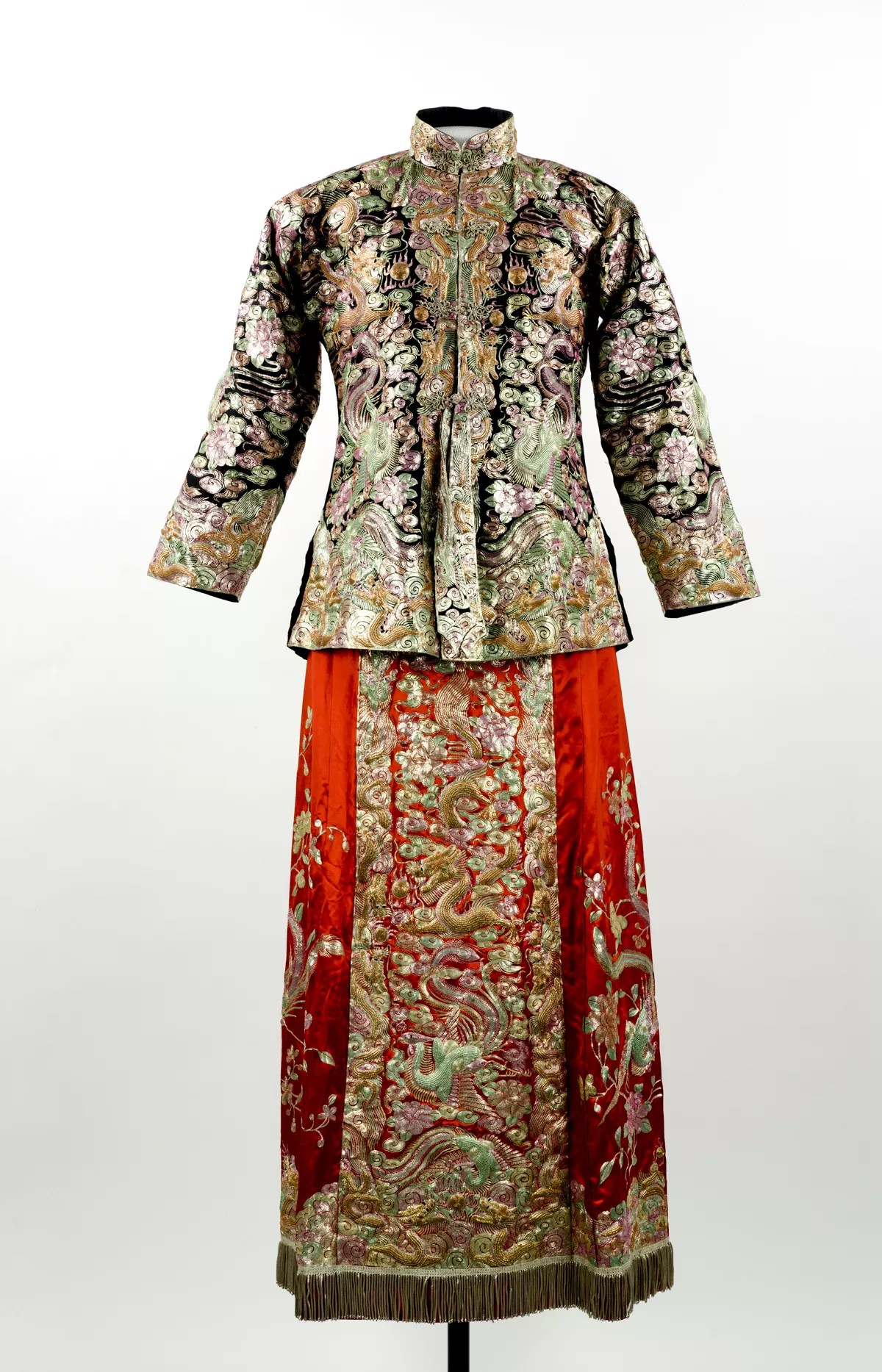
Quon Tai
Courtesy History Colorado Center
Some of History Colorado’s most popular items – Baby Doe’s wedding dress and Indian ledger art detailing battles – were ruled out for conservation reasons (Baby Doe’s dress) or simply because they carried an overwhelming amount of emotional weight (the ledgers). A few other objects were eliminated because of actual weight limitations. History Colorado has a sod house in its collection, but it was too heavy for a floor that wasn’t originally designed for displays; so was a locomotive. Once all the pieces were chosen, they had to be prepared for display – the battle flag from Glorieta Pass, where Chivington won a victory for the Union before he moved on to Sand Creek, is mounted backwards, because that’s how curators preserved it more than a century ago; it’s now behind glass, to avoid further decay. (A window from the exhibit into a conservation area allows visitors to see preservation at work.)
History Colorado worked up to the wire to get the show ready; the display cases were still being installed just two weeks before the November 17 opening. Ultimately, Zoom In went from conception to completion in fourteen months, when most exhibits would take three to five years, Turner says.
The result is a very fast tour through Colorado history, starting with a Folsom spear point from the Lindenmeier site that dates back 13,000 years. When it was found, it revised all estimates of how long humans had lived in the region. A few dozen feet takes you through fourteen more objects – Native American pots, the introduction of the Spanish influence (New World coins and a sword), the migration from Mexico (molds for adobe bricks) and early explorations from the eastern United States (beaver pelts for hats was one of Colorado’s first big exports). The 18th object in the exhibit is the first evidence of the Rush to the Rockies: a Pikes Peak whiskey bottle whose contents helped fuel future miners (and could inspire the pioneers behind Colorado’s now-booming distilling industry). Right next to it is a glittering gold ingot (the most valuable piece in the exhibit); a sewing machine a few objects away offers “another portal into that story,” notes Hanson. “It was a much more reliable way to make a living, if you were providing services to miners.”
The stories continue from there, through a variety of objects all designed to give visitors a taste of Colorado’s wide-ranging past, and to encourage them to tell their own stories inspired by the collection. Turner and Hanson have been surprised by how long people spend at Zoom In, studying the past and making connections. “I love it,” says Hanson. “I go to eavesdrop on them.”
One of the objects that’s really resonated with visitors is a Tenth Mountain Division uniform, at the end of a grouping that shows World War II’s effect on Colorado, including delicate art made at Amache and a sign from the Trinidad camp that held German POWs; the uniform is right next to the first chair lift from Aspen, which debuted in 1947. “One of our education coordinators just took her 93-year-old grandmother in,” Hanson says, “and she started talking about all the people she knew in the Tenth Mountain Division.”

The Mauro Special (1893-’98).
Courtesy History Colorado Center
The connection between other stories isn’t as distinct. “The Mauro Special” bicycle dating from the 1890s highlights how Denver once had the largest concentration of bikes per capita in the country. But the wheels weren’t turning just for sport: Bicycles helped liberate women from the trappings of horse-and-buggy travel, letting them move freely around the booming city. Women soon enjoyed even more freedom: As detailed in the explanation for object 46, a ballot box and case, Colorado became the first state to give women the vote, in 1893. (While still a territory, Wyoming had done the same.) That commitment to women’s rights continued: Seventy-five years later, Colorado became the first state in the union to legalize abortion. (Zoom In contains no object commemorating that landmark.)
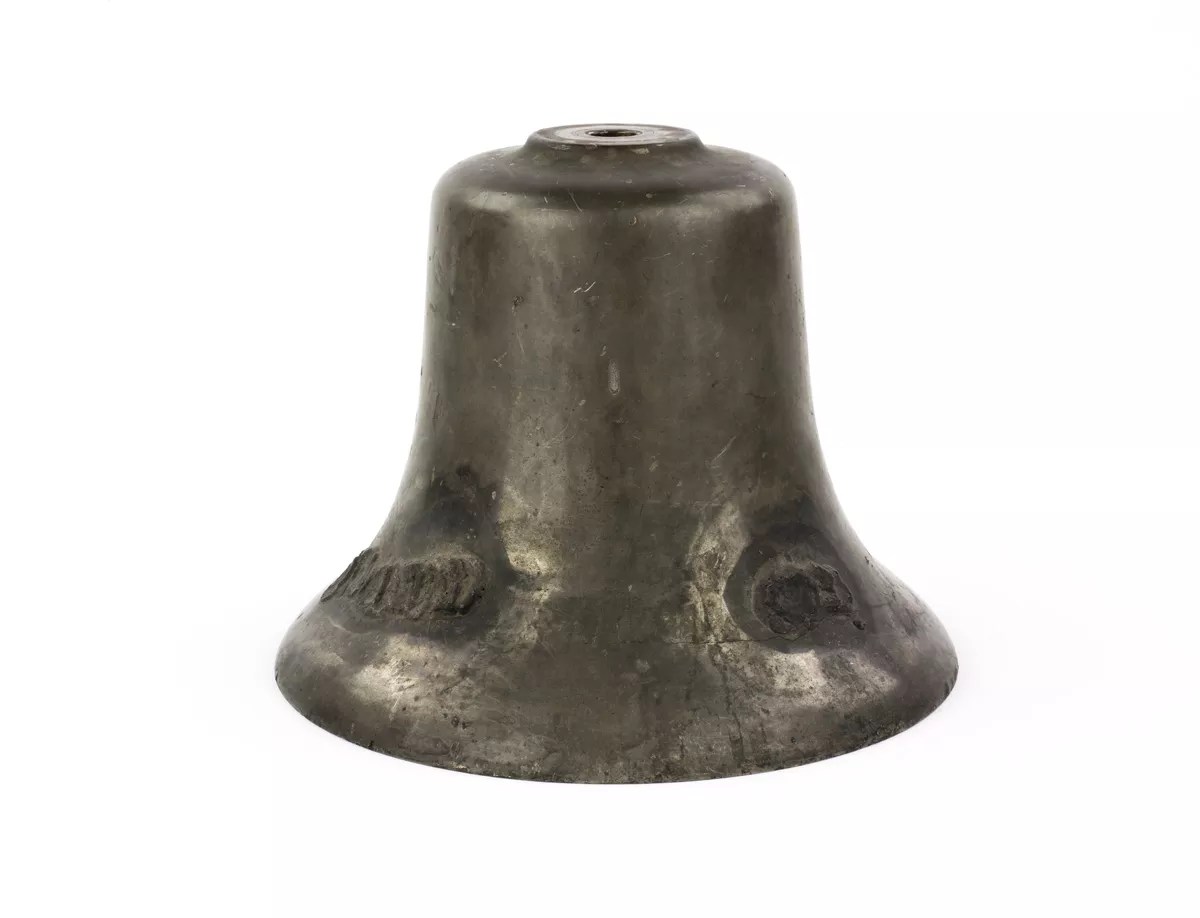
Denver City Market Bell (1900-1939).
Courtesy History Colorado Center
Denver residents who followed the Ink! Coffee gentrification flap should take a look at the Denver City Market Bell, which once rang out over the area of Five Points close to the Platte where Colorado farmers gathered to sell their produce. The residential part of the neighborhood was centered on Welton Street, which was bustling with African-American-owned businesses a century ago. In Zoom In, Denver’s black population is represented by former slave Florence Bell’s crazy quilt from 1893, the sneakers that Wellington Webb wore on his way to becoming mayor in 1991, the Shriner hat that Leroy Smith wore in the 1940s. But in one of the exhibit’s major omissions, there’s no corresponding hood to represent the broad influence of the Ku Klux Klan in Denver in the ’20s. Five-term mayor Benjamin Stapleton was a member of the Klan; that chapter of his résumé is far less known than his role in creating Denver’s first airport.
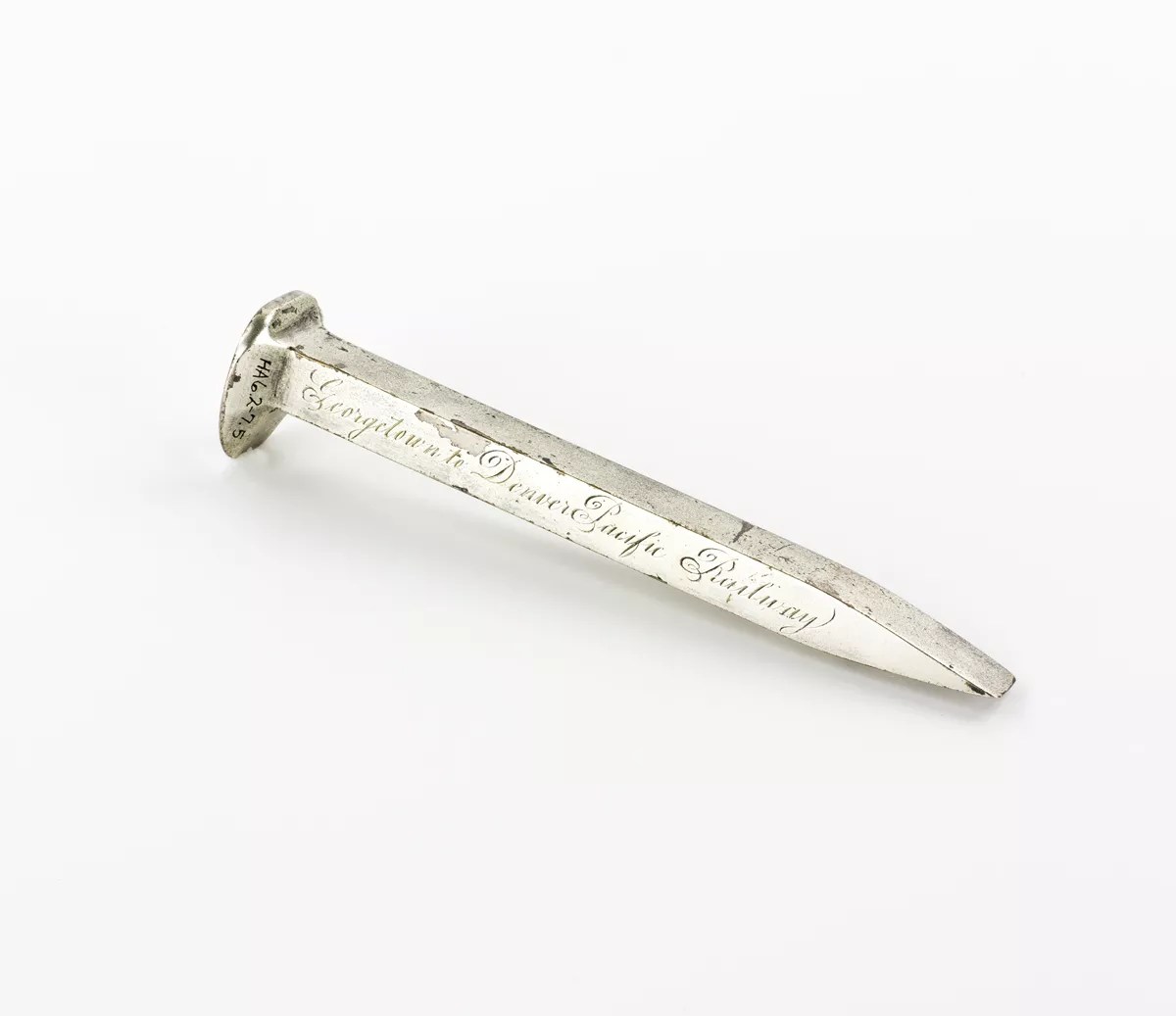
Ceremonial silver railroad spike (1870)
Courtesy History Colorado Center
Denver newcomers are also unlikely to recognize that if history had taken another turn, they might have moved to Cheyenne rather than the Mile High City. Object 32 is a ceremonial silver spike that commemorates the day in 1870 when the Denver Pacific, a hundred-mile line funded by Denver boosters, linked this city with Cheyenne, which the Union Pacific had preferred for an overland route. That move paved the way for Denver to become the rail hub of the Rockies (and for the renovated Union Station to become a hub for Denver nightlife three years ago). Eight decades later, President Dwight Eisenhower (represented here by his WWII jacket), whose wife, Mamie, was a Denver native, pushed the interstate system that sent I-70 right through Denver; today, expansion of that highway has created another fractious chapter in Colorado history.

United Airlines Flight 629 airplane fragment (1955)
Courtesy History Colorado Center
Other transportation-related objects offer ongoing lessons. While an elegant Frontier Airlines dining set should give anyone who flies that Denver-based budget airline a good laugh, it’s next to an object that’s an all-too-real reminder of a grim reality of travel today: Object 79, an airplane fragment from United Airlines Flight 629, also known as “Mainliner Denver.” That flight left Stapleton Airport on November 1, 1955, en route to Portland and Seattle – and blew up over Longmont. Within days, Jack Gilbert Graham confessed that he’d put a bomb in the luggage of his mother, a Denver businesswoman, in order to collect on two insurance policies he’d taken out on her life. All 44 people on board were killed, and Graham was later executed. This was the first case of domestic terrorism in Colorado, but not the last: Object 94 is a sympathy card left at Columbine High School.
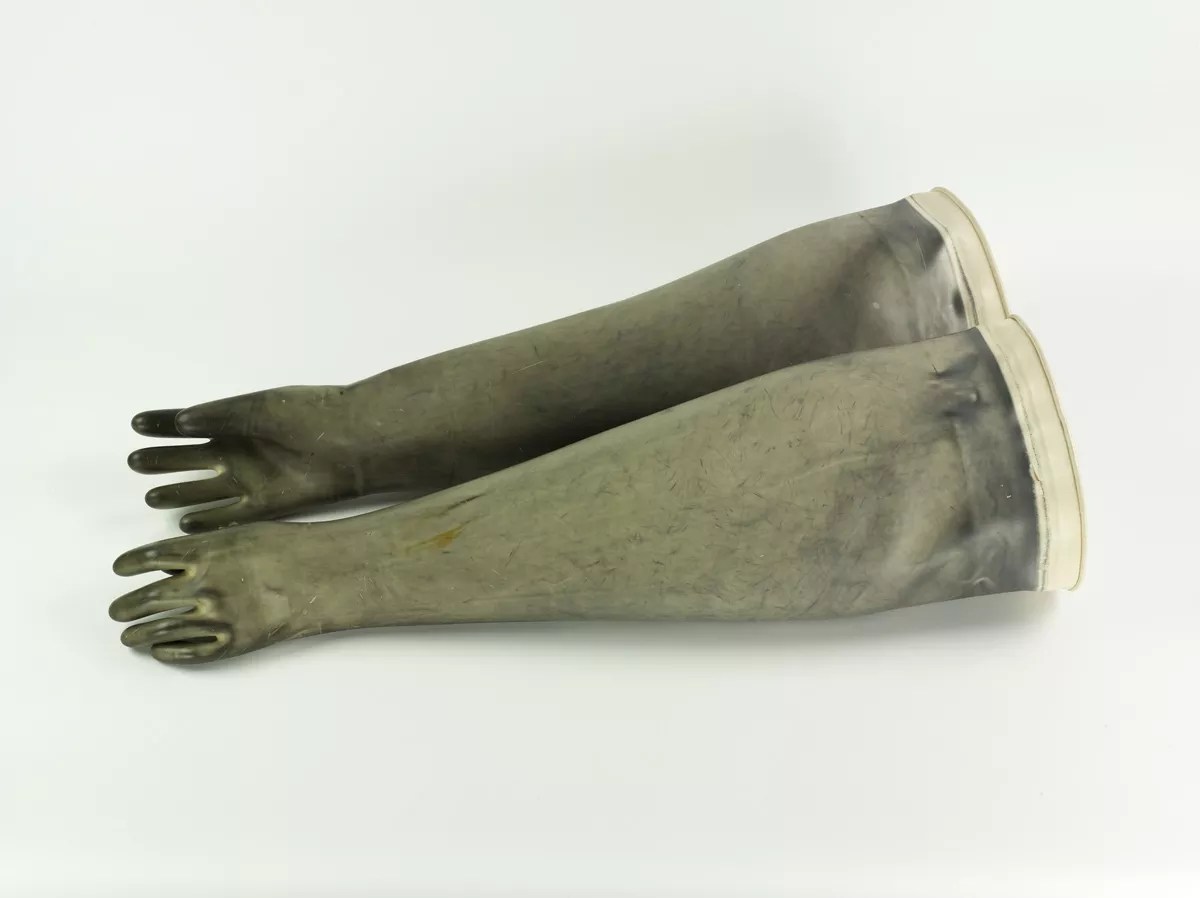
Rocky Flats nuclear facility anti-contamination gloves (1952-1989; 1985-95 used)
Courtesy History Colorado Center
One of the items in the exhibit that particularly impresses visitors is a pair of anti-contamination gloves from the Rocky Flats Nuclear Weapons Plant; Hanson thinks that could be because curators did a striking job of mounting the gloves. But those visitors might be more impressed if they knew the whole story: Not that long ago, Cold War workers used those gloves to help make plutonium triggers for nuclear bombs. In 1989, Rocky Flats got out of the bomb-making business after the FBI raided the plant to investigate alleged environmental crimes there. A grand jury charged with considering the evidence seized during that raid wanted to indict eight individuals; instead, the Department of Justice sealed a deal with Rockwell International, which was operating the plant at the time. A $7 billion cleanup of the facility followed; next year, much of Rocky Flats is slated to become a wildlife refuge open to the public. A portion at the center, where most of the really dirty work was done and those gloves were used, will remain forever off limits…or at least until the history of the place is forgotten.
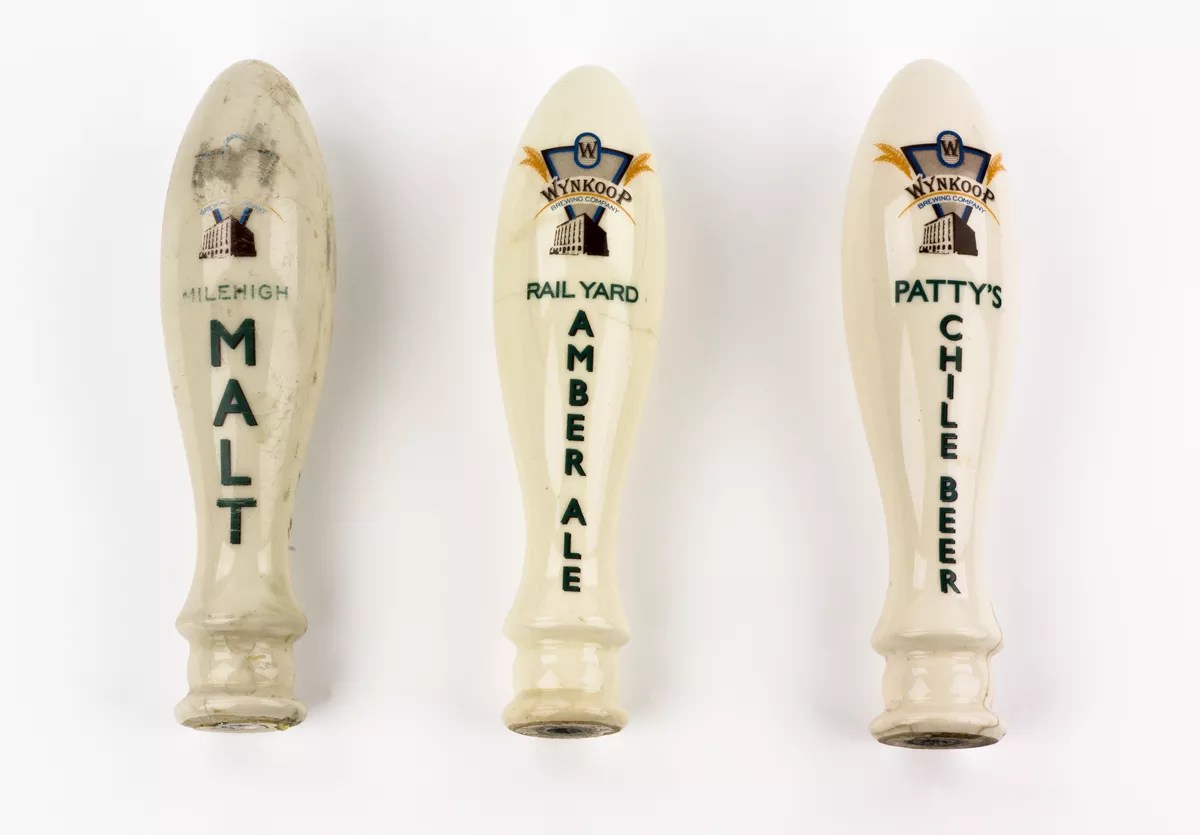
Wynkoop Brewing Company tap handles (about 1988).
Courtesy History Colorado Center
At the end of Zoom In, visitors are encouraged to name their favorite items and suggest what should be the 101st object on display. A number of ideas involve food – green chile, the first cheeseburger – perhaps because visitors get hungry after spending a few hours in the gallery. But there’s plenty of sustenance in the exhibit: Coors is represented by a malted-milk can produced during Prohibition; there’s also a trio of tap handles from the Wynkoop Brewing Company, Denver’s first brewpub that happened to boast a founder who went on to become Denver’s mayor, and now Colorado’s governor. (One of those taps is devoted to Patty’s Chile Beer, which was named after a certain newspaper editor.) And Colorado’s agricultural past isn’t ignored; another grouping includes everything from a beet topper to colorful packing crates to an incredible toy tractor that a father created out of spare parts for his sons during the Dust Bowl. That object has proved a particular favorite with kids…and former kids. One of those sons was at the opening of Zoom In, more than eighty years after he first played with the toy. Other groupings bring together labor stories, Western legends, political movements.
“We tried intentionally to make this a human story,” says Hanson. “Most of these objects are focused on a particular person’s story…and some continue. One thing we want people to walk away with is the sense that you are part of the story. History is made by people.”
And it continues to be made by them. So far, Zoom In has exceeded History Colorado’s expectations, not only bringing people in, but inspiring them to return. “There’s a certain set of people just inclined to want to know more,” Hanson says. History Colorado plans to continue giving more to them, with a book on the exhibit coming next year and playful activities for adults as well as kids. It’s hosting tiny library concerts. It’s plotting a music exhibit, a beer exhibit, even a cannabis exhibit, Turner says. In late January, it will offer a program on how to play the video game Oregon Trail…in real life.
“People don’t wake up on a Saturday morning and think necessarily, ‘I want to go learn something today,'” notes Hanson. “They’re thinking, ‘I want to have fun today.’ If they can learn something, too, it’s a value-added proposition.”
For all of us. “There are so many people moving here, and there are so many ways to reach them about this place we all call home now,” adds Hanson, whose father was in the service and whose family traveled all over the country before settling in Colorado. “They want to find us, and we want to be sure we’re ready when they do.”